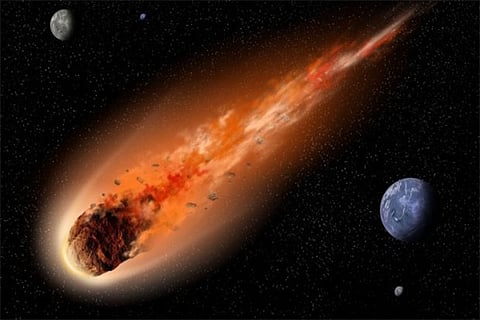

Chennai
For decades, scientists have debated the identity of the impactor that struck our planet that fateful day, leaving a 90-mile scar called the Chicxulub crater under what is now the Yucatán Peninsula in Mexico. Although an asteroid remains the leading candidate, a team based at the Center for Astrophysics, in Cambridge, Mass., has proposed that the culprit may have been an icy comet that flew too close to the sun. When long-period comets from the outer reaches of the solar system approach the sun, they can be torn asunder by the star’s immense tidal forces. The resulting shards may have been catapulted across Earth’s orbit, providing “a satisfactory explanation for the origin of the impactor” that killed the dinosaurs, according to a study published on Monday in Scientific Reports.
“To this day, the origin of the Chicxulub impactor remains an open question,” said Amir Siraj, an undergraduate studying astrophysics at Harvard who led the research. His model, he said, examines “this special population of comets” that could have produced enough shards — of the right size, at the right rate and on the right trajectories — to threaten Earth “in a way that’s consistent with current observational constraints.”
Other experts disagreed with the study’s methods and conclusions. “I believe their work has several intrinsic problems that work against their hypothesis,” said Bill Bottke, a planetary scientist at the Southwest Research Institute in Boulder, Colo. From the perspective of Siraj and his co-author, the Harvard theoretical physicist Avi Loeb, a cometary origin fills some of the gaps in our understanding of this ancient cataclysm, which prompted the so-called KT extinction event, signifying the end of the Cretaceous period and the start of the Tertiary.
The researchers cite evidence that the impactor was composed of carbonaceous chondrites, a rocky material found in a class of primitive asteroids that date to the birth of the solar system. Samples returned from Comet Wild 2 in 2006 revealed evidence that the icy world has a similar composition, suggesting that this makeup “could potentially be widespread in comets,” the researchers note in the study. The team speculates that the Vredefort crater, in South Africa, and the Zhamanshin crater, in Kazakhstan, may also be remnants of cometary impacts.
“The fact that long-period comets are likely to be made of the material — carbonaceous chondrites — that is deep in these craters is in support of our model,” Dr. Loeb said.
The researchers argue that factoring sun-splintered comets into impact models increases the rate of hazardous Chicxulub-scale objects by an order of magnitude, increasing the odds that Earth was struck by a comet fragment 66 million years ago. Natalia Artemieva, a senior scientist at the Planetary Science Institute in Tucson, Ariz., dismissed this cometary-origin hypothesis. The four-mile-wide comet fragments envisioned by the study would have been too small to create the Chicxulub crater, she said. She noted the tell-tale spike of iridium that was deposited in the aftermath of the impact and that is visible in geological strata all around the world. Although Dr. Bottke remains unconvinced that the impactor had a cometary origin, he noted that the asteroid explanation also raised many exciting and unresolved questions. “Ultimately, the more we look to nature, the closer we can get to answering fundamental questions about the world around us — about the past, but also about the future,” Siraj said. “That’s the beauty of science.”
Ferreira is a reporter with NYT©2020
The New York Times
Visit news.dtnext.in to explore our interactive epaper!
Download the DT Next app for more exciting features!
Click here for iOS
Click here for Android